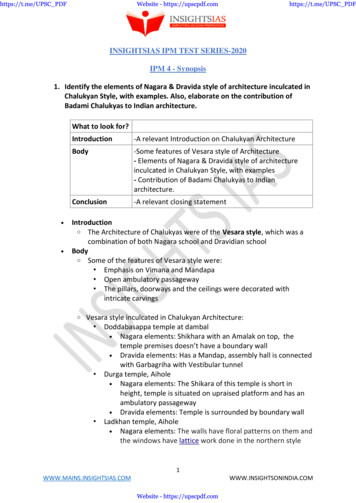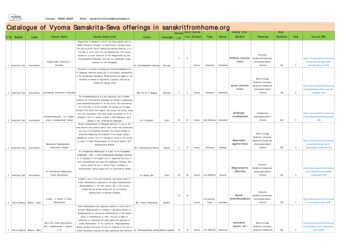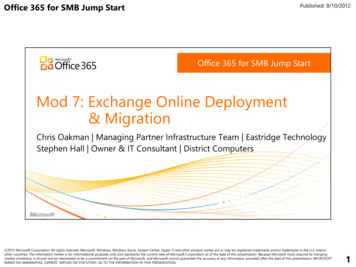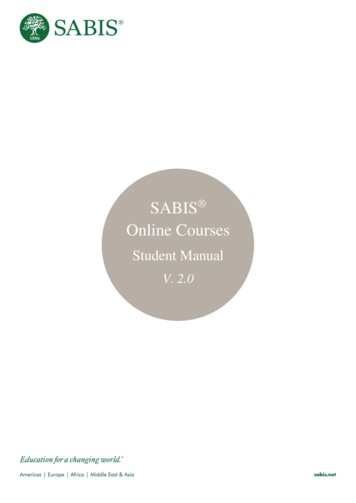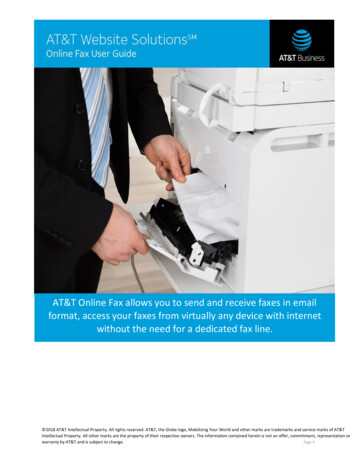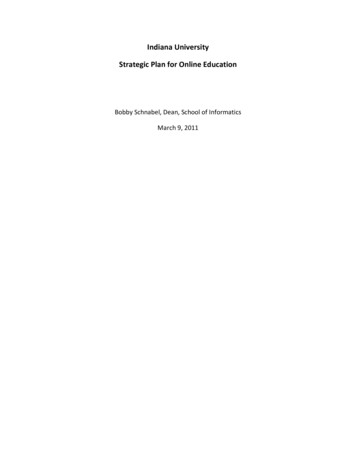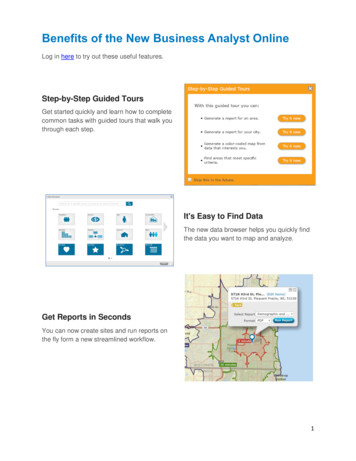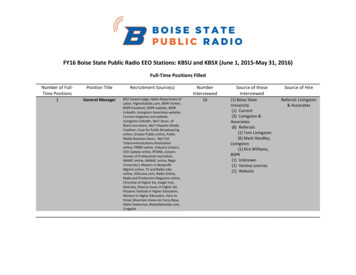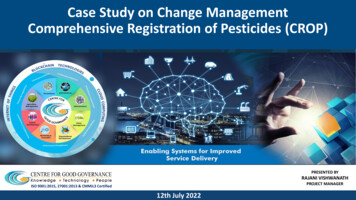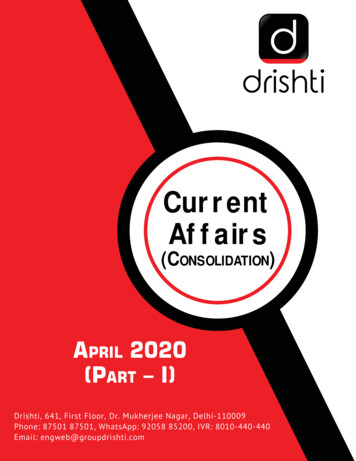
Transcription
CurrentAffairs(CONSOLIDaTION)April 2020(Part – I)Drishti, 641, First Floor, Dr. Mukherjee Nagar, Delhi-110009Phone: 87501 87501, WhatsApp: 92058 85200, IVR: 8010-440-440Email: engweb@groupdrishti.com
ContentsPolity and Governance. 1zSupreme Court Upholds Right to Discuss Covid-19.1zSupreme Court on Free Testing of Covid-19.2zFloor Test is Governor’s Discretion: SC.2zRestrictions on Court Hearings Lawful.3zCentre Defines J&K Domicile Rules.4zNational Security Act, 1980.6zForeign Contribution to PM-CARES Fund.7zCorporate Social Responsibility Expenditure.7zTaxation and Other Laws (Relaxation of Certain Provisions) Ordinance, 2020.8zState Disaster Response Funds .9zMP’s Salaries Cut and MPLADS Suspended.9zNorms Relaxed under MPLAD Scheme.10zLockdown Extened .11zICMR Advises ‘Pool Testing’ of Covid-19.12zPrivacy Concern Over Aarogya Setu App.12zSahyog App: Survey of India.13zSchool Education & Covid-19.13zBharat Padhe Online and YUKTI Portal: MHRD.15zSAMADHAN Challenge.15zIndian Migrants and Challenges.16zNational Investigation Agency.16zMeasures for Smooth Disbursal of Funds Under PMGKY.18zExpert Panel Against Full Repeal of lockdown.19zNeighboring Rights Law.20zCovid-19 Impact on Measles Immunization Program.20zMeasures for Farmers’ Welfare.21zNew Features Added to e-NAM.22zSchemes for Electronic Manufacturing.23zWomen SHGs Fight Against Covid-19.24zDeendayal Antyodaya Yojana-National Rural Livelihoods Mission.25zHealthcare Institutions Face Cyber Threats.25Economic Scenario.27zImpact of Covid-19 on Global Economy.27zWorld Economic Outlook Report: IMF.28zWorld Bank on India’s Growth.29zMonetary Policy Report.30
zImpact of Economic Slowdown Due to Covid-19.31zRBI’s Measures to Fight Economic Disruptions.33zE-Way Bills During Lockdown.33zCore Sector Growth at 5.5%.34zDemand for MGNREGA Work Increased.35zFundraising for Covid-19.36zImpact of Lockdown on Banks.36zEPFO Disbursed Claims.37zFall in IHS Markit India Services Business Activity Index.38zFraud Oversight Wing.39zNBFCs Face Moratorium Issue with Banks.39zRenewable Energy Certificates.40zGovernment Cuts Interest Rates on NSC, PPF.41International Relations.42zGlobalisation & Covid-19.42zIndia-China: 70 Years of Diplomatic Relations.43zTalks on Oil Cut Deal at G-20.45zIMF Cancels Debt Payments.46zADB Assures Covid-19 Support Package .47zSyrian Air Force Behind Chemical Attacks.48zThreat of Food Shortage: UN, FAO and WTO.49zIndia Moves WTO on US Tariffs .49zChina at Top in Global Patent Race.50zIndia-Pak Tension Amidst Covid-19.50zASEAN Summit on Covid-19.51zChinese Trawlers in South China Sea.52zOperation Sanjeevani.53Science and Technology.54zScience of Covid-19 Spread.54zCovid-19 & Cytokine Storms.55zKerala Gets Nod for Trial of Plasma Therapy.56zCoronavirus Infection Rate: The Lancet.57zSuggestions for Covid-19 and Lockdown Exit.58zSequencing Novel Coronavirus.59zEbola Death in Democratic Republic of Congo.60zRecovery Curve and Case Rate Curve.62zFalse Negative Tests: A Concern.62zTest Positivity Rate.63zFight Against Covid-19.63zSATYAM: Yoga Against Viruses.65zEffect of BCG Vaccine on Covid-19.66
Environment and Ecology.68zArmyworm Attack.68zAgasthyavanam Biological Park.69zKoundinya Wildlife Sanctuary.69zAnimals and Covid-19.70zWildlife Panel Holds Virtual Conference.71zIonospheric Based Monitoring of Large Earthquakes.71Social Issues.73zRise in Violence Against Women Amidst Lockdown.73zGender Disparity and Covid-19.75zRare Diseases.75zCovid-19 Community Mobility Report: Google.76zKendriya Bhandar.76Miscellaneous.78zMadhuban Gajar: Biofortified Variety.78zYanomami Tribe.79zCovid-19 Affects Odisha’s Art and Festival.79zWorld Health Day.80zWimbledon Postponed due to Covid-19.80
w w w. d r i s h ti IA S.c omCURRENT AFFAIRS APRIL 2020Polity and GovernanceHighlightszSupreme Court Upholds Right to Discuss Covid-19zSahyog App: Survey of IndiazSupreme Court on Free Testing of Covid-19zSchool Education & Covid-19zFloor Test is Governor’s Discretion: SCzBharat Padhe Online and YUKTI Portal: MHRDzRestrictions on Court Hearings LawfulzSAMADHAN ChallengezCentre Defines J&K Domicile RuleszIndian Migrants and ChallengeszNational Security Act, 1980zNational Investigation AgencyzForeign Contribution to PM-CARES FundzMeasures for Smooth Disbursal of Funds Under PMGKYzCorporate Social Responsibility ExpenditurezExpert Panel Against Full Repeal of lockdownzTaxation and Other Laws (Relaxation of Certain Provisions)Ordinance, 2020zNeighboring Rights LawzState Disaster Response FundsCovid-19 Impact on Measles Immunization ProgramzzzMP’s Salaries Cut and MPLADS SuspendedMeasures for Farmers’ WelfarezNorms Relaxed under MPLAD SchemeNew Features Added to e-NAMzzLockdown ExtendedSchemes for Electronic ManufacturingzzICMR Advises ‘Pool Testing’ of Covid-19Women SHGs Fight Against Covid-19zzzPrivacy Concern Over Aarogya Setu AppDeendayal Antyodaya Yojana-National Rural Livelihoods MissionzHealthcare Institutions Face Cyber ThreatsSupreme Court UpholdsRight to Discuss Covid-19Why in NewsRecently, the Central government appealed in theSupreme Court that media outlets, in the “larger interestof justice”, should only publish or telecast anything onCovid-19 after ascertaining the factual position from thegovernment.Key Points¾Note:According to the government, “any deliberate orinaccurate” reporting by the media, particularly webportals, in the midst of an unprecedented situation canhave a “serious and inevitable potential of causingpanic in a larger section of the society”. The government blamed “fake and misleading”messages on social media for creating widespreadpanic, which led to mass “barefoot” journeys ofmigrant workers from cities to their native villagesin rural India.Related Constitutional Provisions¾ Article 19(1)(a) of the Constitution of India statesthat, “all citizens shall have the right to freedomof speech and expression”. The philosophy behind this Article lies in thePreamble of the Constitution, where a solemnresolve is made to secure to all its citizens, libertyof thought and expression.¾ The exercise of this right is, however, subject to“reasonable restrictions” for certain purposes beingimposed under Article 19(2) of the Constitutionof India. These reasonable restrictions are imposed inthe interests of the sovereignty and integrity ofIndia, the security of the State, friendly relationswith foreign States, public order, decency ormorality or in relation to contempt of court,defamation or incitement to an offence.1
2www.d rish t i I A S. c o mCURRENT AFFAIRS APRIL 2020The mass migration of the poor would defeatthe preventive measures taken by the Centralgovernment to contain pandemic.¾ The Supreme court took a view balancing free pressand the need to avoid panic in society during anunprecedented crisis. The Court upheld the right to free discussion aboutCovid-19, and directed the media to refer to andpublish the official version of the developments inorder to avoid inaccuracies and large-scale panic. It ordered the government to start a daily bulletinon Covid-19 developments through all mediaavenues in the next 24 hours. ¾¾¾Supreme Court onFree Testing of Covid-19Why in NewsThe Supreme Court modified its April 8, 2020 orderto clarify on free testing for Covid-19.¾Key Points¾¾¾¾¾Private labs would continue to charge the IndianCouncil of Medical Research (ICMR) rates of up to 4,500 for tests from people who can afford to pay.Free testing for Covid-19 shall continue to be madeavailable to the poor eligible under the AyushmanBharat Pradhan Mantri Jan Arogya Yojana.Free testing would also be made available to any othercategory of economically weaker sections of societyas notified by the government from time to time.The Supreme Court directed the Ministry of Health& Family Welfare to identify beneficiaries among theweaker sections of society. This includes workers belonging to low incomegroups in the informal sectors and beneficiaries ofDirect Benefit Transfer who can be made eligiblefor free testing.It also directed the Ministry to issue appropriateguidelines in this regard within a week.Ayushman Bharat Pradhan Mantri Jan Arogya¾ PM-JAY offers a sum insured of Rs.5 lakh per familyfor secondary care (which doesn’t involve a superspecialist) as well as tertiary care (which involvesa super specialist).Note:¾It is an entitlement-based scheme that targets thebeneficiaries as identified by latest Socio-EconomicCaste Census (SECC) data. Once identified by the database, the beneficiaryis considered insured and can walk into anyempanelled hospital.The funding for the scheme is shared – 60:40 for allstates and UTs with their own legislature, 90:10 inNortheast states and Jammu and Kashmir, Himachaland Uttarakhand and 100% Central funding for UTswithout legislature.Packaged rates(Rates that include everything sothat each product or service is not charged forseparately): They also mention the number of average daysof hospitalization for a medical procedure andsupporting documents that are needed. They are flexible, but hospitals can’t charge thebeneficiary once the rates are fixed.The National Health Agency has been constituted asan autonomous entity under the Society RegistrationAct, 1860 for effective implementation of PM-JAYin alliance with state governments.The State Health Agency (SHA) is the apex bodyof the State Government responsible for theimplementation of AB PM-JAY in the State.Floor Test isGovernor’s Discretion: SCWhy in NewsRecently, the Supreme Court of India has held thata Governor can call for a floor test any time he/sheobjectively feels a government in power has lost theconfidence of the House and is on shaky ground.Key Highlights¾The S.C. held that a Governor can call for a trust vote(confidence motion) if he/she has arrived at a primafacie opinion, based on objective material, that theincumbent State government has lost its majority inthe Assembly. However, while directing a trust vote, the Governorshould not favour a particular political party.
w w w. d r i s h ti IA S.c omTiming of a trust vote may tilt the balance towardsthe party possessing a majority at the time thetrust vote is directed.¾ Governor’s power to call for a floor test is not restrictedonly before the inception of a State governmentimmediately after elections, but continues throughoutits term.¾ The SC has clarified that the Governor’s power oftrust vote does not hamper any disqualificationproceedings pending before the Speaker. A Governor need not wait for the Speaker’sdecision on the resignation of rebel Members ofLegislative Assembly (MLAs) before calling for atrust vote. Trust VoteCURRENT AFFAIRS APRIL 2020Constitutional Provisions Related to Governor¾ Article 163: It talks about the discretionary powerof the governor.¾ Article 256: The executive power of the Union shallextend to the giving of such directions to a Stateas may appear to the Government of India to benecessary for that purpose.¾ Article 257: The executive power of the Union shallalso extend to the giving of directions to a State asto the construction and maintenance of means ofcommunication declared in the direction to be ofnational or military importance.¾ Article 355: It entrusts the duty upon the Union toprotect the states against “external aggression” and“internal disturbance” to ensure that the governmentof every State is carried on in accordance with theprovisions of the Constitution.¾ Article 356: In the event that a state governmentis unable to function according to constitutionalprovisions, the Central government can take directcontrol of the state machinery. The state’s governorissues the proclamation, after obtaining the consentof the President of India.¾ Article 357: It deals with Exercise of legislativepowers under Proclamation issued under Article356 by the central government.A confidence motion or a vote of confidence or atrust vote, is sought by the government in power onthe floor of the House.¾ It enables the elected representatives to determine ifthe Council of Ministers commanded the confidenceof the House.¾ The idea underlying the trust vote is to uphold thepolitical accountability of the elected governmentto the State legislature.¾ No-confidence motion: A no-confidence motion, or vote of no-confidence,or a no-trust vote, can be sought by any Housemember to express that they no longer haveconfidence in the government.Restrictions onCourt Hearings LawfulFloor TestWhy in News¾It is a term used for the test of the majority. If thereare doubts against the Chief Minister (CM) of aState, he/she can be asked to prove the majorityin the House. In case of a coalition government, the CM maybe asked to move a vote of confidence and wina majority.¾ In the absence of a clear majority, when there ismore than one individual staking claim to form thegovernment, the Governor may call for a specialsession to see who has the majority to form thegovernment. Some legislators may be absent or choose not tovote. The numbers are then considered basedonly on those MLAs who were present to vote.¾Note:Recently, the Supreme Court held that all restrictionsimposed on people from entering, attending or takingpart in court hearings are lawful in the wake of theCovid-19 pandemic.¾ The court said these restrictions were in tune withthe social distancing norms and best public healthpractices advocated to contain the Covid-19.Key Points¾Duty vs Discretion: The apex court invoked itsextraordinary Constitutional powers under Article142 to step away from the convention of opencourt hearings. It further clarified that use of thisextraordinary power was not a matter of discretionbut of duty.3
4www.d rish t i I A S. c o mCURRENT AFFAIRS APRIL 2020Convention vs Public Health: Although the opencourt system ensures transparency in administrationof justice, scaling down of conventional operationswas done to avoid congregation of a large numberof people. The court made it clear that public healthtakes precedence over conventions.¾ Cooperation and Participation: The court said everyindividual and institution is expected to cooperate inthe implementation of measures designed to reducethe transmission of the virus. It also argued courts at all levels respond to thecall of social distancing and ensure that courtpremises do not contribute to the spread of virus.¾ Covid-19 and Rule of Law: Access to justice isfundamental to preserve the rule of law in thedemocracy envisaged by the Constitution of India. Inthe absence of access to justice, people are unable tohave their voice heard, exercise their rights, challengediscrimination or hold decision-makers accountable. The challenges occasioned by the outbreak ofCovid-19 have to be addressed while preservingthe constitutional commitment to ensuring thedelivery of and access to justice to those who seek it.¾ICT and Delivery of JusticeGuidelines: The Supreme Court also issued the followingguidelines to streamline the use of Informationand Communications Technology (ICT) in effectivedelivery of Justice: High Courts: The High Courts to decide themodalities for the use of videoconferencingtechnologies in their respective States. District Courts: District courts in each State wouldadopt the mode of videoconferencing prescribedby the respective High Courts. Helplines: Helplines to be set up to receive andrectify technical complaints.¾ The courts should make available video conferencingfacilities for litigants who do not have it or appointan amicus curiae (friend of the court).¾ Mutual Consent of Parties: The court said in no caseshall evidence be recorded without the mutual consentof both the parties by videoconferencing.¾ Social Distancing: If it is necessary to record evidencein a courtroom, the presiding officer shall ensure thesocial distancing to be followed.¾Note:Article 142¾ It provides discretionary power to the SupremeCourt as it states that the Supreme Court in theexercise of its jurisdiction may pass such decree ormake such order as is necessary for doing completejustice in any cause or matter pending before it.¾ Constructive Application: In the early years of theevolution of Article 142, the general public andthe lawyers both lauded the Supreme Court for itsefforts to bring complete justice to various deprivedsections of society or to protect the environment.¾ In the Union Carbide case, relating to the victims ofthe Bhopal gas tragedy, the Supreme Court placeditself above the laws made by the Parliament orthe legislatures of the States by saying that, to docomplete justice, it could even override the lawsmade by Parliament. However, in the Supreme Court Bar Associationv. Union of India, the Supreme Court stated thatArticle 142 could not be used to supplant theexisting law, but only to supplement the law.¾ Cases of Judicial Overreach: In recent years, therehave been several judgments of the Supreme Courtwherein it has been foraying into areas which hadlong been forbidden to the judiciary by reason ofthe doctrine of ‘separation of powers’, which ispart of the basic structure of the Constitution. Onesuch example is: The ban on the sale of alcohol along nationaland state highways: While the notification bythe central government prohibited liquor storesalong National Highways only, the Supreme Courtput in place a ban on a distance of 500 metresby invoking Article 142.Centre DefinesJ&K Domicile RulesWhy in NewsRecently, the Ministry of Home Affairs (MHA) hasissued the Jammu and Kashmir Reorganisation(Adaptation of State Laws) Order, 2020.¾ On 6th August 2019, the Centre revoked J&K’s specialstatus under Article 370 and Article 35A of theConstitution and bifurcated it into the UTs of J&Kand Ladakh.
w w w. d r i s h ti IA S.c omThe two revoked constitutional provisions let thestate legislature decide the ‘permanent residents’,prohibiting a non-J&K resident from buying propertythere and ensuring job reservation for its residents.¾ There are 12 States, including Himachal Pradesh, whereprovisions of special status under Article 371 apply. The provisions pertain to regulation of ownershipand transfer of land in order to conserve the limitedresources available for development and to ensurethat the State preserves its unique identity. Key Highlights of Order¾¾¾¾¾Note:It amended 109 laws and repealed 29 laws of theerstwhile State and inserted the ‘domicile’ clause in theJammu and Kashmir Civil Services (Decentralisationand Recruitment) Act, 2010.The cla
Polity and Governance . 1 z Supreme Court Upholds Right to Discuss Covid-19
